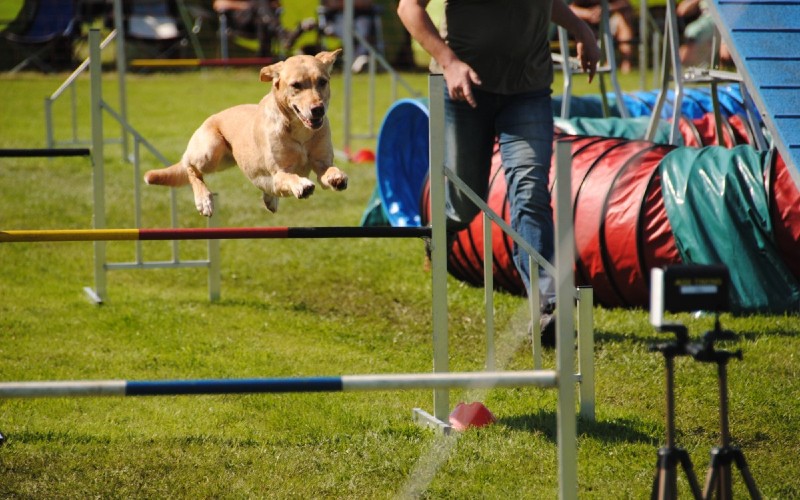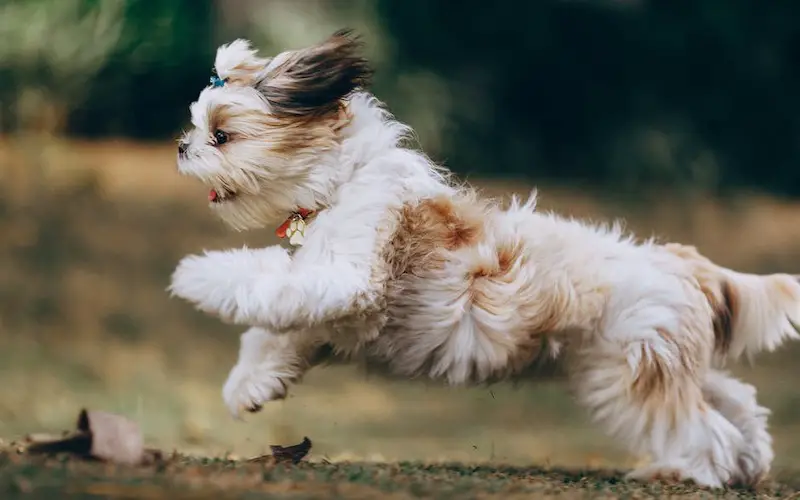Dog agility can be a fun activity to do with your dog and can be a great beginning to training for sports while keeping your dog healthy and active. Agility training provides a way for dogs to exercise their bodies and minds and bond with their owners. If your dog is still a puppy and you’re working on obedience training, you might want to start the agility training at home before trying out agility classes.
Most dogs need to be over the age of one year for agility competitions, so if you want to train your puppy early, there are some prep exercises you can begin with to get started. These will help to get both you and your puppy prepared to jump into dog agility.
If you start with at-home training for your puppy, make sure to use agility prep activities that coincide with your puppy’s age. Introducing them to low-level exercises and equipment will help them learn and understand and feel confident when moving into authentic agility training.
Benefits of Agility Training
So, why consider agility training for your dog? Multiple benefits stem from training your dog in agility, such as:
- Reducing or effectively solving behavioral problems, like separation anxiety or aggression
- Off-leash loyalty, building strong trust, and better communication between you and your dog
- Gaining exceptional skills and learning new tricks
- Having fun
Sometimes, owners have noticed that after exercising their dogs with a long walk or run, their dogs still have tons of energy instead of feeling worn out. Why is this? It was most likely because the dog’s mind did not get any exercise, even though its body did. Agility combines both in a way that not only builds a great connection between you and your dog but allows your dog to exercise body and mind.
Another added benefit of providing your dog with agility training is that there is no pressure. Expectations are based on your dog’s understanding of the tasks and exercises given, without any added timeline or stress on how quickly they can learn it. You can easily set your dog up for success by starting slowly and going at their pace.
It is important to remember that dogs respond well to praise and encouragement. If you begin with some at-home agility training, remember to keep your sessions relatively short and fun so that your dog doesn’t lose interest and wants to continue with it.

Socialisation
Dogs get a significant boost of confidence when performing agility, which goes a long way for socialization. A factor in socializing your dog is allowing it to become comfortable and relaxed with everything around it, and agility training can be a massive benefit towards this. Rewarding your dog after completing a task or exercise promotes the willingness to do and learn more.
Flexibility
Dogs will learn many new tricks with agility, and they work to increase coordination and strength. Agility courses are similar to obstacle courses. Working with your dog on tasks such as target placement, adjusting positions, and jumping through a hoop are great preparation exercises while allowing your dog to become more flexible and have fun.
Essential body awareness is a significant factor in providing dogs with agility. Simple tricks like bowing help your dog stretch, and others like weaving figure eights are great introductions to weave around poles in an agility course.
Attention
As the owner, you will receive more attention from your dog with agility training. You both work as a team, with your dog focused entirely on you to take direction on where to go during the training, so drowning out distractions and surroundings become important. How you handle your dog will reflect how well they can run an agility course, so communication is essential.
It would help foster increased attention from your dog by making eye contact or using the cue for “watch me” or “look” when you want your dog to go in a particular direction. When you begin training for agility in this manner, you would like to start somewhere quiet to ensure you are getting full attention, and then gradually increase the sounds and surroundings as your dog’s skills become more advanced.
Agility Exercise
Some suggestions that you can utilize if you want to train your dog for agility include basic commands to move your dog where you want it to go. You can send the dog out in front of you, moving from one side to another, or putting the dog at a distance from you so that it is comfortable working alongside you in any capacity. Work on walking with the dog in the same place so that it becomes relaxed being by your side or just out in front when walking, then you can jog, and eventually, run so that it registers the difference in pace.
Reward your dog with treats and praise each time it does the correct action so that it learns quickly what to do and what not to do. You can use the treats to toss in the direction of where you want the dog to go and give an added boost, so it figures out where to go and that it does not need to stay strictly by your side.
From here, you can work to teach your dog to wrap around objects or turn more tightly around them. Using a thing similar to a cone, like a garbage can, you can send your dog out and around the object. Working to turn tightly around objects helps your dog to become more aware of its body and how to place each paw, which is a considerable advantage in agility.
Keep in mind while doing any training to have your dog’s health and safety at the forefront. Bond Vet in Garden City, NY advises that if you are training your dog in agility at home to watch for signs of distress. If you notice that your dog is getting exhausted or possibly is in pain, stop working and address their needs. Dogs can’t communicate when they need to stop, so it is up to us as their owners to keep a close watch and not let them overdo it.
When you work on some of these basic agility skills at home, you and your dog will feel more prepared to enter the sport or take agility classes. You can start with entry-level agility and see how well your handling skills are and if you and your dog have good communication and can continue learning. If you want to teach your puppy more skills, you can see if there are any local classes tailored to young dogs as well. You and your dog will soon be enjoying the remarkable bond and benefits that come from the sport.
If you enjoyed this article you might also like to read about Dog Barn St Helens and Dog Agility London

